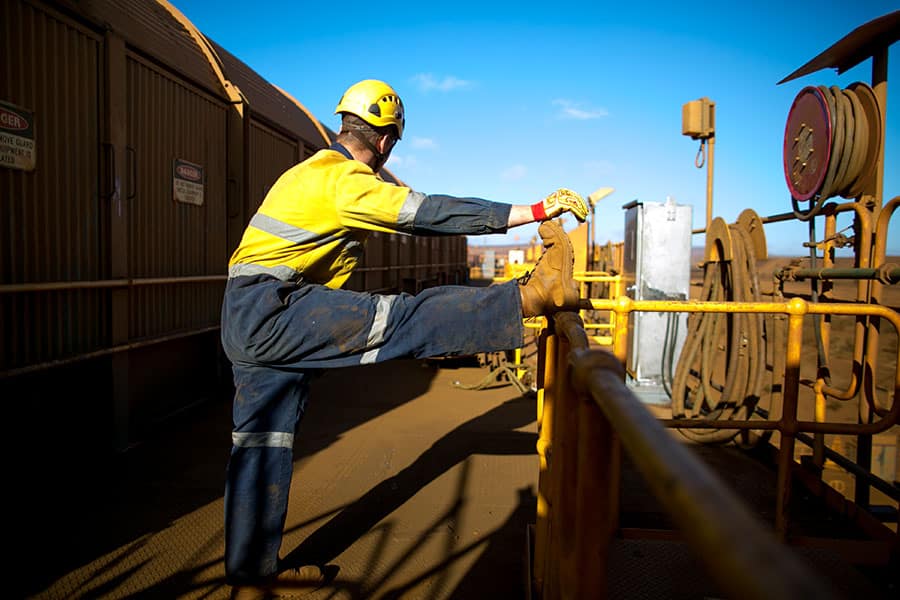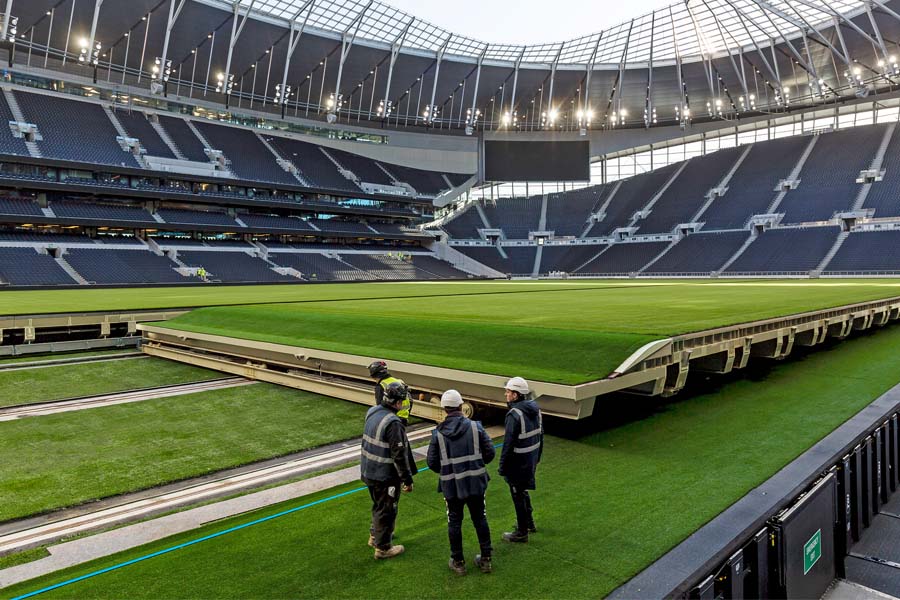On most mornings, Pepper Construction Group Superintendent Chad Czerwinski leads his crew in a series of stretches to limber up sore or sleepy muscles for another day on the jobsite. All it takes is five minutes, and it usually comes after the morning safety talk to highlight potential hazards for the day.
Just like a runner wouldn’t start a marathon without a stretching session, construction workers who have a long day of physical labor ahead of them also need to prepare their bodies. “We’re getting ready to go up there and do heavy lifting, shoveling, whatever it is,” Czerwinski said, “and it does pay to take a few minutes in the morning.”
Stretch-and-flex programs have been on construction jobsites for decades to reduce sprains, strains, back pain and other musculoskeletal disorders, which account for about one-third of all construction injuries and take workers off the job.
“It’s honestly pretty simple,” said Dan Ruane, Pepper’s vice president for safety, who is working to expand its stretch-and-flex and wellness programs. “With sprains and strains always being the leading cause of injuries, stretching out and being prepared for the day is really one of the most basic things you can do to try to prevent those. So that’s why everybody’s been trying to do it for years.”
Yet on busy jobsites, looming deadlines can push stretch-and-flex programs off the schedule. Here’s why they matter, especially now, and how to launch or reinvigorate the one you have.
All about the movement
Keeping workers on the job may be more important than ever as the industry grapples with a workforce shortage of 650,000 and opportunities for a piece of the $1 trillion federal infrastructure program. A daily stretch-and-flex program won’t solve the industry’s labor crisis, but keeping workers healthy can reduce delays and ensure your people are ready for what’s next.
“We’re struggling in the industry just to cover the work that needs to be done with people,” said Tom Kommer, who teaches construction management courses at California Polytechnic State University and worked in construction for 30 years. “So, keeping them safe, keeping them healthy is essential.”
The jury is out on just how well stretch-and-flex programs reduce the actual cost of dealing with these common injuries, according to researchers who have reviewed academic studies that assessed the programs. But they can increase muscle flexibility and joint range of motion and decrease stiffness and joint and muscle discomfort, the researchers found.
RELATED:
There is also evidence of workers’ compensation cost savings. According to insurance company Assurance, one company’s wellness program, which includes stretch-and-flex, saved $142,000 in annual costs.
“Anything that’s going to help pull more blood and nutrients to the muscle is going to reduce any muscle strain,” said Dr. Sargon Benjamin Odisho, a chiropractic physician and owner of The Chicago Fix. Odisho developed the wellness program studied by Assurance, which includes stretch-and-flex and a wellness clinic.
Still, the bigger reason that the programs work, Dr. Odisho said, is because of proprioception, a medical term that defines the awareness that we have of the location and movement of our body. “By waking up proprioception, you reduce a lot of the soft tissue injuries. Just by doing a little stretch a couple of minutes wakes up the muscles,” Odisho said.
They come with another benefit as well, according to Czerwinski: the ability to check in on workers each morning to spot and address any lingering injuries from the day or night before. “It gives you a chance, as the person running the crew, to see what condition people are in when they come in in the morning,” he said.
5 tips for better stretching and flexing
While stretch-and-flex programs have been around for decades, programs can fizzle out over time as delays mount and crews just want to finish the job. Here are five ways to boost your stretch-and-flex participation.
Get the super involved
In any workplace, company culture, including one that focuses on wellness and safety, is stronger when leaders get involved. When the superintendent is touching his toes too, it sends a message that stretching before the day begins is the right thing to do. “That’s absolutely important that the top dog in the field is engaged, doing the exact same stretches,” Kommer said.
Turn it over to the crew
While Czerwinski leads stretch-and-flex activities, he also hands it off to crew members to lead about once a week. It becomes more of a group effort. “Some of them are more hesitant than others,” he said. “Some of them are just better communicators and are able to speak or throw their voice because it’s loud in the morning.”
Fall back on software
Instead of relying on the honor system, tailor your project management software to include a sign-in for the sessions. That way workers must check whether they participated, and the foreman can scan daily reports to see who might be skipping. “It becomes part of the daily reports, and they’re going to be more inclined to not lie about it,” Kommer said.
Switch up your game
Simple stretches that you did to warm up before your high school basketball game years ago may be all you need. Dr. Odisho recommends tailoring the session to the work happening that day. Concrete workers often suffer lower back and knee injuries, so he would focus stretches on those areas. Drywallers, meanwhile, might want to focus on their shoulders and back, he said. Glean ideas for new stretches on YouTube where construction companies have posted their own routines.
Focus on every benefit
Some companies may be inclined to give up on a program if they don’t see any savings on their workers’ compensation costs. But Linda M. Goldenhar, director of research and evaluation at The Center for Construction Research and Training, who investigated why contractors continue to use stretch-and-flex programs despite lack of solid evidence on the bottom line, said it’s not just about cost reduction.
Workers cultivate teamwork and camaraderie as they gather for a few minutes each day to stretch it out. And Goldenhar, who has a doctorate degree in public health, said it’s another opportunity for construction companies to send a message that they care about their employees’ well-being.
“Even if a company initially starts a stretch-and-flex program because of workers’ comp costs, they’re going to get better participation if it’s perceived by the worker that they care about them,” she said, “and that they want them to be as safe as possible while working to get the job done.”














